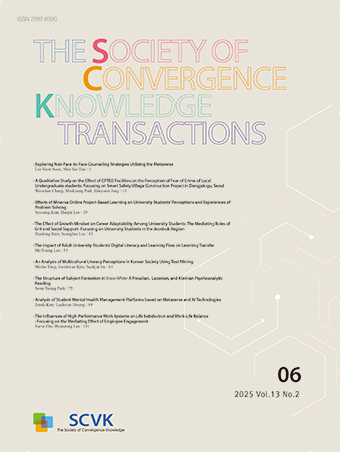Research Article
Abstract
References
Information
데이터 마이닝 클러스터링 기술은 동일한 클러스터 내에서 유사한 특성을 나타내는 개체를 함께 그룹화하고 여러 특성을 나타내는 개체를 클러스터로 그룹화 하는데 사용된다. 클러스터링 방법은 하드 클러스터링과 소프트 클러스터링의 두 가지로 분류 할 수 있다. 본 논문에서는 Fuzzy C-Means 알고리즘(FCM), Fuzzy Possibilistic C-Means 알고리즘(FPCM) 및 Modified Fuzzy Possibilistic C-Means 알고리즘(MFPCM)과 같은 다양한 퍼지 클러스터링 알고리즘의 장ㆍ단점을 살펴보고, 시간.공간 복잡도를 수행하고 비교 분석한다. 또한, 다양한 FCM 알고리즘을 데이터 마이닝, 의학, 이미지, 패턴 감지, 생물 정보학 및 기타 과학 및 엔지니어링 응용 프로그램과 같은 대용량의 분야에 확장 응용하여 연구할 계획이다.
Data mining clustering techniques are used to group objects with similar characteristics together within the same cluster and to group objects with multiple characteristics into clusters. Clustering methods can be classified into two types, hard clustering and soft clustering. This paper examines the advantages and disadvantages of various fuzzy clustering algorithms such as Fuzzy C-Means Algorithm (FCM), Fuzzy Possibilistic C-Means Algorithm (FPCM), and Modified Fuzzy Possibilistic C-Means Algorithm (MFPCM). Perform, compare and analyze. In addition, the company plans to expand and apply various FCM algorithms to high-volume applications such as data mining, medicine, imaging, pattern detection, bioinformatics and other scientific and engineering applications.
- Soumi Ghosh, Sanjay Kumar Dubey, “Comparative Analysis of K-Means and Fuzzy C-Means Algorithms”, (IJACSA) International Journal of Advanced Computer Science and Applications, Vol. 4, No. 4, 2013.10.14569/IJACSA.2013.040406
- Binsy Thomas, Madhu Nashipudimath, “Comparative Analysis Of Fuzzy Clustering Algorithms In Data Mining”, ISSN: 2277-9043 International J ournal of Advanced Research in Computer Science and Electronics Engineering (IJARCSEE) Volume 1, Issue 7, September 2012.
- Nidhi Grover, “A study of various Fuzzy Clustering Algorithms”, International Journal of Engineering Research, ISSN: 2319-6890) (online), 2347-5013(print) Volume No. 3, Issue No. 3, pp. 177-181, 01 March 2014.10.17950/ijer/v3s3/310
- G. Beliakov, and M. King, “Density based fuzzy c-means clustering of non-convex patterns”, School of Information Technology, Deakin University, 221 Burwood Hwy, Burwood 3125, Australia, 2005.
- J. Yang, Y. Ma, X. Zhang, and S. Li, “A Method for Initializing the K-means Clustering Algorithm Using Delaunay Triangulation”, Article · June 2017 with 2 Reads.10.12783/dtetr/apetc2017/11374
- Gyeong Heo, Jinseok Seo, Imgeun Lee, “Problems in Fuzzy C-Means and Its Possible Solutions”, Korean Internet Information Institute, 16(1), Jan. 2011.10.9708/jksci.2011.16.1.039
- Christian Correa, Constantino Valero, Pilar Barreiro, Maria P. Diago, and Javier Tard_aguila, “A Comparison of Fuzzy Clustering Algorithms Applied to Feature Extraction on Vineyard”, http://www.etsia.upm.es.
- Mohamed Fadhel Saad and Adel M. Alimi, “Modified Fuzzy Possibilistic C-means”, Proceedings of the International Multi Conference of Engineers and Computer Scientists 2009 Vol I IMECS 2009, March 18 – 20, 2009, Hong Kong.
- M.H. Fazel Zarandi, M. Zarinbal, and I.B. Turksen, “Type-II Fuzzy Possibilistic C-Mean Clustering”, IFSA-EUSFLAT 2009.
- J. Bezdek Pattern Recognition with Fuzzy Objective Function Algorithms, Plenum Press, New York 1981.10.1007/978-1-4757-0450-1
- Publisher :The Society of Convergence Knowledge
- Publisher(Ko) :융복합지식학회
- Journal Title :The Society of Convergence Knowledge Transactions
- Journal Title(Ko) :융복합지식학회논문지
- Volume : 7
- No :4
- Pages :11-17
- DOI :https://doi.org/10.22716/sckt.2019.7.4.046




 The Society of Convergence Knowledge Transactions
The Society of Convergence Knowledge Transactions







